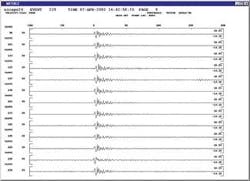Tubing-conveyed borehole deployment isolates seismic sensors
A new technology allows seismic sen-sors that are acoustically isolated from flow-noise to be placed in live wells as part of the completion, allowing conti-nuous seismic reservoir monitoring, the system developer says.
The common industry vision of 4D seismic reservoir monitoring relies on integrated networks of permanently deployed seafloor and downhole seismic sensors. In the case of downhole seismic sensors, the high cost of drilling observation wells means that, to be viable, sensors must be deployed in flowing wells (production or injection).
ABB Offshore Systems has designed a tubing-conveyed borehole deployment system that it says isolates seismic sensors from flow noise while coupling the sensors to the formation. This capability is achieved by a locking system that is conveyed on the tubing, but is physically isolated from it once it is set. This is in contrast to bow-spring type deployment mechanisms where the geophones remain coupled to the tubing. Coupling to the formation is comparable to being directly attached to the inside or the outside of the casing, ABB says, while being resonant-free across the seismic frequency range.
The system, called PS3 (pronounced PS-cubed), allows non-intrusive seismic instrumentation of high flowrate wells, the company says, while achieving complete de-coupling of the receivers from flow-induced acoustic noise. Testing shows the deployment technology effective at flowrates of 30,000 b/d or more. Noise rejection capabilities are 30 to 40 dB better than other deployment mechanisms, according to ABB.
Methodology
In 2000, ABB embarked on an integrated research and development program with the aim of measuring and understanding the fundamental processes involved in acoustic noise generation and transmission within oilfield completions.
The following key requirements were identified:
- Low flow noise coupling, which enables monitoring
- High vector fidelity; i.e., resonance free across the seismic frequency range
- Acceptability to well engineers.
The first challenge was finding a way to make detailed laboratory-type measurements in the environment of a flowing well. The solution was to construct a two-ended well section. A 15-m-long inclined double-ended borehole was drilled through the vertical face of a granite quarry at ABB's Deep Borehole Test Site in Cornwall in the UK. The borehole was cased with (47 lb/ft) 9 5/8-in. standard oilfield casing, which can accommodate a variety of tubing sizes and elements of a typical well completion. The casing was cemen- ted in place with a string of three-component geophones permanently cemented behind the casing to ensure coupling to the casing and formation. Two 60,000-liter storage tanks allow fluid to flow through the borehole at rates of up to 30,000 b/d using gravity drive to avoid contamination from pump noise.
A small, 2-cu-m test block was included in the flow loop to perform more precise measurements, and to allow easy investigation of the flow noise while maintaining a close resemblance to a real oil well. The system is designed to be flexible, so that changing the positions and types of geophones, acceler-ometers, and hydrophones can be done easily. Flow noise, both single-phase and multi-phase, was monitored in different parts of the completion and test block at a variety of flow rates (of 5,000-30,000 bs/d were used to sim- ulate production conditions). Data was recor- ded using a 72-channel data acquisition system.
null
null
The physical experimentation was run in parallel with numerical modeling and mechanical system investigations. An iterative process was developed, which allowed new ideas to be tested experimentally using insights gained from previous experiments and numerical modeling. ABB enlisted the help of flow acoustics experts from the TNO research institute in the Netherlands.
Scientific investigations were also conducted to determine the effects of different materials on the transmission of flow-generated noise within a completion. As a result of various experiments, a special ex-centralizer was designed to optimize the system performance. The ex-centralizer that hold the tubing away from the casing allow the system to be deployed into horizontal wells with no acoustic coupling between the tubing and the sensors.
According to ABB, the system opens wider opportunities for borehole seismic instrumentation and reservoir monitoring, because decoupling the seismic sensors from the flow noise, allows detection of smaller and more distant seismic/micro-seismic signals. The decoupling mechanism is held in a compressed state during the run-in operation. Once the tubing string is in place, the mechanism can be released by elevating the pressure in either the tubing or the annulus or via a hydraulic line. The mechanism then releases from the tubing and clamps itself to the inside of the casing.
The system is expandable, and the oper-ator can specify the number of levels and their positioning along the well. Pressure and temperature sensors can also be incorporated, if required. The system is rated to 300° F and 10,000 psi (150° C / 690 bar).





